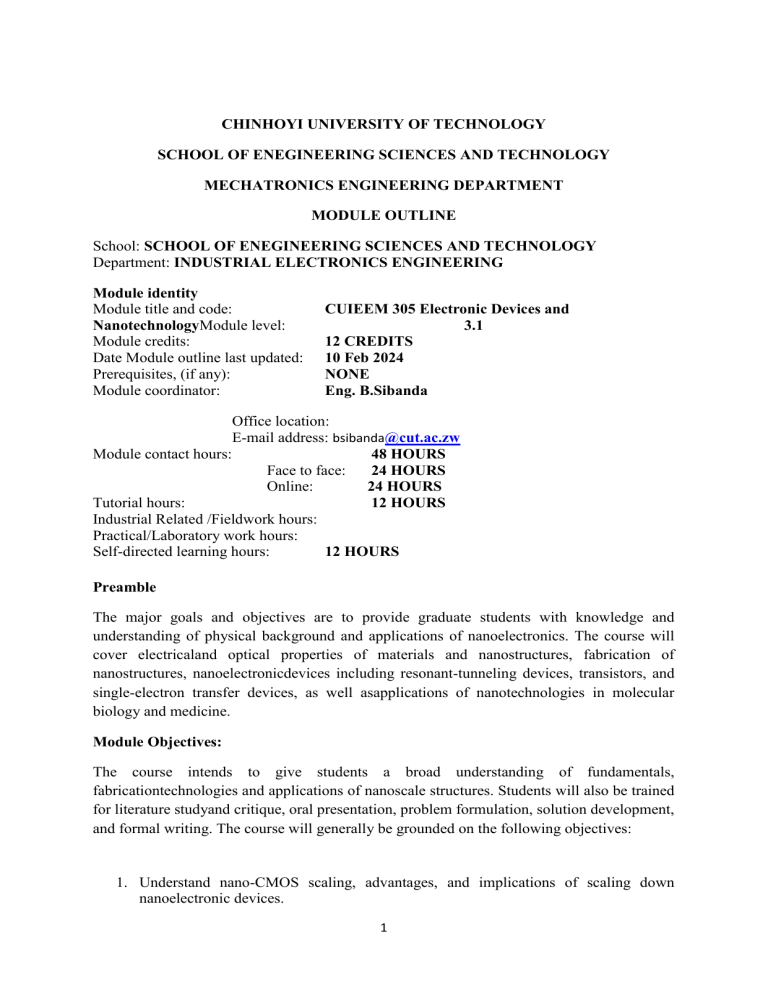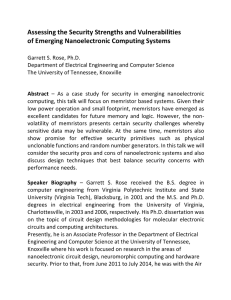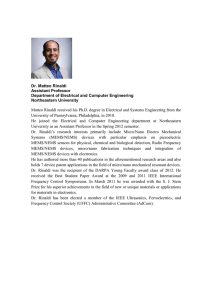
CHINHOYI UNIVERSITY OF TECHNOLOGY SCHOOL OF ENEGINEERING SCIENCES AND TECHNOLOGY MECHATRONICS ENGINEERING DEPARTMENT MODULE OUTLINE School: SCHOOL OF ENEGINEERING SCIENCES AND TECHNOLOGY Department: INDUSTRIAL ELECTRONICS ENGINEERING Module identity Module title and code: NanotechnologyModule level: Module credits: Date Module outline last updated: Prerequisites, (if any): Module coordinator: CUIEEM 305 Electronic Devices and 3.1 12 CREDITS 10 Feb 2024 NONE Eng. B.Sibanda Office location: E-mail address: bsibanda@cut.ac.zw Module contact hours: 48 HOURS Face to face: 24 HOURS Online: 24 HOURS Tutorial hours: 12 HOURS Industrial Related /Fieldwork hours: Practical/Laboratory work hours: Self-directed learning hours: 12 HOURS Preamble The major goals and objectives are to provide graduate students with knowledge and understanding of physical background and applications of nanoelectronics. The course will cover electricaland optical properties of materials and nanostructures, fabrication of nanostructures, nanoelectronicdevices including resonant-tunneling devices, transistors, and single-electron transfer devices, as well asapplications of nanotechnologies in molecular biology and medicine. Module Objectives: The course intends to give students a broad understanding of fundamentals, fabricationtechnologies and applications of nanoscale structures. Students will also be trained for literature studyand critique, oral presentation, problem formulation, solution development, and formal writing. The course will generally be grounded on the following objectives: 1. Understand nano-CMOS scaling, advantages, and implications of scaling down nanoelectronic devices. 1 2. Describe the solid-state physics and quantum mechanics that govern the operation and electrical characteristics of nanoelectronic devices. 3. Explain different fabrication and characterization techniques for nanoscale electronic devices. 4. Study 3D ICs and progress in interconnect technology. 5. Understand the importance and significance of key reliability issues in nanoelectronic devices and materials. 6. Become familiar with recent research progress related to new devices and materials, and its application in nanoelectronics and nanotechnology field. Expected Learning Outcomes: At the end of the course the student will be able to: Describe the challenges of CMOS scaling beyond 65nm technology, possible solutions and advantages/challenges of scaling down devices. Explain distinct phenomena of semiconductor physics and carrier transport that are important in nanoelectronic devices. Understand advanced concepts and operating principles of nanoelectronic devices. Understand specialized methods to fabricate nanoscale devices. Gain familiarity with the application of advanced techniques needed to characterize and study reliability of materials and nanoscale electronic devices. Understand the applications of nanoelectronic devices in logic/memory and other related applications. Describe the structure-physics property relationship, operating principles, merits, demerits and challenges of some of the futuristic nanoelectronic devices. Explore application of nanoscale devices in different nanoelectronic and nanotechnology related engineering fields. Delivery Methods: Continuous Assessment will apply, including tests, tutorials, assignments fieldwork and laboratory reports. A pass mark of 50% is required. The final exam will contribute 70% and 30% will be from continuous assessment. Overall the assessment includes the following: 1. Regular homework assignments 2. In-class tests 3. Tutorials assessments 4. Oral presentations 5. Field trips 6. Mini design projects 7. Laboratory practical reports 2 8. End of Semester Examination Detailed Content layout to include Topics (outline) / Module content detailed with activities, assignments, tests, timing, practical work/ lab work. (This information can be presented in tabular form as shown in the table below). Day Topics Content/concepts/detaile d Methodolo gy employed Student activities 1 Introductio n to confinemen t Introduction to synthesis of nanostructure materials, Bottom-up approach and Topdown approach with examples-Trapped particles-Quantum dots and artificial atoms-Quantum wires and Quantum wells. Teaching, Blended learning Research on availability of quantum physics NanoSemicondu ctor technology Tunnel junction and applications of tunneling, Tunneling Through a Potential Barrier, Metal—Insulator, Metal-Semiconductor, and Metal-InsulatorMetal Junctions, Coulomb Blockade, Tunnel Junctions, Tunnel Junction Excited by a Current Source. Spintronics and Foundations of nanophotonics, Field Emission, Gate— Oxide Tunneling and Hot Electron Effects in nano MOSFETs, Theory of Scanning Tunneling Microscope, Double Teaching, Blended learning Assignment 1 2 3 4 5 6 3 Durati on/time (for content ) 6hrs 16hrs Barrier Tunneling and the Resonant Tunneling Diode. 7 MEMS and NEMS Technilogy 8 9 10 Nano Electronics and Spintronics Introduction to MEMS and NEMS, working principles, as micro sensors (acoustic wave sensor, biomedical and biosensor, chemical sensor, optical sensor, capacitive sensor, pressure sensor and thermal sensor), micro actuation (thermal actuation, piezoelectric actuation and electrostatic actuation–micro gripers, motors, valves, pumps, accelerometers, fluidics and capillary electrophoresis, active and passive micro fluidic devices, Pizoresistivity, Pizoelectricity and thermoelectricity, MEMS/NEMS design, processing, Oxidation, Sputter deposition, Evaporation, Chemical vapor deposition etc Teaching, Blended learning Introduction – Scaling of physical systems – Geometric scaling & Electrical system scaling. The SingleElectron Transistor: The Single- Electron Transistor SingleElectron Teaching, Blended learning 4 Research on MEMs and NEMs Systems Test 1 16hrs Assignment 2 Test 2 16hrs Transistor Logic, Other SET and FET Structures, Carbon Nanotube Transistors (FETs and SETs), Semiconductor Nanowire FETs and SETs,Coulomb Blockade in a Nanocapacitor, Molecular SETs and Molecular Electronics. Assessment: Assignments 5% Tests 25% References: Online access to course material on central server, including online journal with assistance of the library Information will be provided periodically on relevant text books, internet resources and other reading material References Texts: 1. Stephen D. Sentaria, Microsystem Design, Kluwer Academic Press 2. Marc Madou, Fundamentals of microfabrication & Nanofabrication. 3. Fukada & W.Mens, Micro Mechanical system Principle & Technology, Elsevier,1998. 4. Julian W.Gardnes, Vijay K. Varda, Micro sensors MEMS & Smart Devices, 2001. 5. Nano Terchnology and Nano Electronics – Materials, devices and measurementTechniques by WR Fahrner – Springe 6. Nano: The Essentials – Understanding Nano Scinece and Nanotechnology by T.Pradeep; Tata Mc.Graw Hill. 7. Spin Electronics by M. Ziese and M.J. Thornton 8. Nanoelectronics and Nanosystems – From Transistor to Molecular and Quantum Devicesby Karl Goser, Peter Glosekotter, Jan Dienstuhl 9. Silicon Nanoelectronics by Shunri Odo and David Feny, CRC Press, Taylor & FranicdGroup 10. Nanotubes and nanowires by C.N.R. Rao and A. Govindaraj, RSC Publishing 11. Quantum-Based Electronic Devices and Systems by M. Dutta and M.A. Stroscio, WorldScientific. 12. James R Sheats and Bruce w.Smith, “Microlithography Science and Technology”, Marcel Dekker Inc., New York, 1998. 13. J.P. Hirth and G.M.Pound “Evaporation: Nucleation and Growth Kinetics” Pergamon Press, Oxford, 1996 5 Academic integrity: Articulate policies for attendance, withdrawal, late assignment submission; plagiarism; statement of academic integrity should be clarified. The University policy on plagiarism and general behavior is to be adhered to all the time. Attendance register will be signed everyday with at least 80% attendance to be allowed to sit for the Institute examination.Pass mark for continuous 50% and no student will be allowed to sit for the Final Examination examination without passing continuous assessments.The continuous assessment will contribute 30% to the overall mark and then Final examination will contribute 70%.Students are expected to exhibit good work ethics and behavior in class i.e Punctuality for lectures Sit for the online tests/quiz during the required window period Being in the right place at the right time Being courteous Hand in all work on time Use of cell phone in class is not permitted. Above all communicate with the lecturer on any issues pertaining to the course. 6


